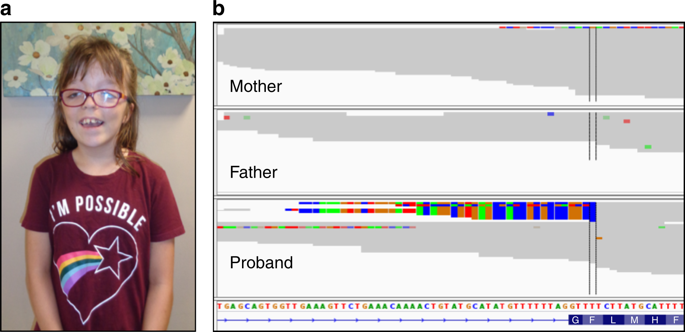当前位置:
X-MOL 学术
›
Genet. Med.
›
论文详情
Our official English website, www.x-mol.net, welcomes your feedback! (Note: you will need to create a separate account there.)
Mobile element insertion detection in 89,874 clinical exomes.
Genetics in Medicine ( IF 8.8 ) Pub Date : 2020-01-22 , DOI: 10.1038/s41436-020-0749-x Rebecca I Torene 1 , Kevin Galens 1 , Shuxi Liu 1 , Kevin Arvai 1 , Carlos Borroto 1 , Julie Scuffins 1 , Zhancheng Zhang 1 , Bethany Friedman 1 , Hana Sroka 1 , Jennifer Heeley 2 , Erin Beaver 2 , Lorne Clarke 3 , Sarah Neil 3 , Jagdeep Walia 4 , Danna Hull 4 , Jane Juusola 1 , Kyle Retterer 1
Genetics in Medicine ( IF 8.8 ) Pub Date : 2020-01-22 , DOI: 10.1038/s41436-020-0749-x Rebecca I Torene 1 , Kevin Galens 1 , Shuxi Liu 1 , Kevin Arvai 1 , Carlos Borroto 1 , Julie Scuffins 1 , Zhancheng Zhang 1 , Bethany Friedman 1 , Hana Sroka 1 , Jennifer Heeley 2 , Erin Beaver 2 , Lorne Clarke 3 , Sarah Neil 3 , Jagdeep Walia 4 , Danna Hull 4 , Jane Juusola 1 , Kyle Retterer 1
Affiliation

|
PURPOSE
Exome sequencing (ES) is increasingly used for the diagnosis of rare genetic disease. However, some pathogenic sequence variants within the exome go undetected due to the technical difficulty of identifying them. Mobile element insertions (MEIs) are a known cause of genetic disease in humans but have been historically difficult to detect via ES and similar targeted sequencing methods.
METHODS
We developed and applied a novel MEI detection method prospectively to samples received for clinical ES beginning in November 2017. Positive MEI findings were confirmed by an orthogonal method and reported back to the ordering provider. In this study, we examined 89,874 samples from 38,871 cases.
RESULTS
Diagnostic MEIs were present in 0.03% (95% binomial test confidence interval: 0.02-0.06%) of all cases and account for 0.15% (95% binomial test confidence interval: 0.08-0.25%) of cases with a molecular diagnosis. One diagnostic MEI was a novel founder event. Most patients with pathogenic MEIs had prior genetic testing, three of whom had previous negative DNA sequencing analysis of the diagnostic gene.
CONCLUSION
MEI detection from ES is a valuable diagnostic tool, reveals molecular findings that may be undetected by other sequencing assays, and increases diagnostic yield by 0.15%.
中文翻译:

89,874 个临床外显子组中的移动元素插入检测。
目的 外显子组测序 (ES) 越来越多地用于罕见遗传病的诊断。然而,由于识别它们的技术难度,外显子组中的一些致病序列变异未被检测到。移动元件插入 (MEI) 是人类遗传病的已知原因,但在历史上很难通过 ES 和类似的靶向测序方法检测到。方法我们从 2017 年 11 月开始,前瞻性地开发和应用了一种新的 MEI 检测方法,用于临床 ES 的样本。阳性 MEI 发现通过正交方法得到确认,并报告给订购提供商。在这项研究中,我们检查了来自 38,871 个病例的 89,874 个样本。结果 诊断性 MEI 存在于所有病例的 0.03%(95% 二项式检验置信区间:0.02-0.06%)中,占 0。15%(95% 二项式检验置信区间:0.08-0.25%)的病例具有分子诊断。一个诊断 MEI 是一个新颖的创始人事件。大多数具有致病性 MEI 的患者之前进行过基因检测,其中三人之前对诊断基因进行了阴性 DNA 测序分析。结论 来自 ES 的 MEI 检测是一种有价值的诊断工具,可以揭示其他测序分析可能无法检测到的分子发现,并将诊断率提高 0.15%。
更新日期:2020-01-22
中文翻译:

89,874 个临床外显子组中的移动元素插入检测。
目的 外显子组测序 (ES) 越来越多地用于罕见遗传病的诊断。然而,由于识别它们的技术难度,外显子组中的一些致病序列变异未被检测到。移动元件插入 (MEI) 是人类遗传病的已知原因,但在历史上很难通过 ES 和类似的靶向测序方法检测到。方法我们从 2017 年 11 月开始,前瞻性地开发和应用了一种新的 MEI 检测方法,用于临床 ES 的样本。阳性 MEI 发现通过正交方法得到确认,并报告给订购提供商。在这项研究中,我们检查了来自 38,871 个病例的 89,874 个样本。结果 诊断性 MEI 存在于所有病例的 0.03%(95% 二项式检验置信区间:0.02-0.06%)中,占 0。15%(95% 二项式检验置信区间:0.08-0.25%)的病例具有分子诊断。一个诊断 MEI 是一个新颖的创始人事件。大多数具有致病性 MEI 的患者之前进行过基因检测,其中三人之前对诊断基因进行了阴性 DNA 测序分析。结论 来自 ES 的 MEI 检测是一种有价值的诊断工具,可以揭示其他测序分析可能无法检测到的分子发现,并将诊断率提高 0.15%。

























 京公网安备 11010802027423号
京公网安备 11010802027423号